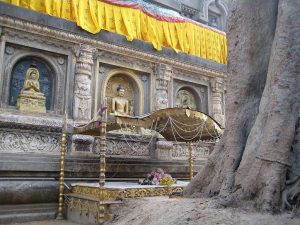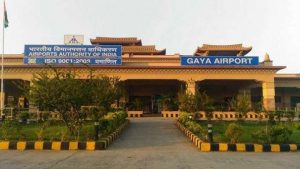This summer, I was fortunate to have made a short visit to Thailand, a country that is home to thousands of Buddhist temples of wondrous appearance and beauty. The seemingly homogeneous architectural design of the temples dominating the skyline of Bangkok disguises the diversity of religious practices and spiritual traditions in the city. Wat Pho remained an unfamiliar name to me until a Thai friend, a professor at Silpakorn University named Mr. U-tain, strongly recommended that I not miss the place: “When you visit Bangkok you must go to Wat Pho [monastery]. It is so unique in its architecture, beautiful stupas, corridor with many golden Buddha statues, a nice garden . . . [but the] central attraction is the gigantic reclining Buddha statue,” he enthused.
Acting on his suggestion, I went to Wat Pho with two of my friends. One, Venerable Tilokananda, a Bangladeshi monk who has been living in Thailand for more than four years, served as guide. Much to my delight, he had many amusing stories to tell. Once, when he was going to Wat Pho from the Grand Palace (which is virtually next door) by tuk-tuk with some tourists, the driver tried to charge them 150 Thai baht (about US$5). After a heated altercation the sum was paid, but Ven. Tilokananda advised the tourists never to take a tuk-tuk in Bangkok again.
The temple has a long history. In 1788, when the capital moved from Thonburi across the river to Bangkok, King Rama I (r. 1782–1809) ordered the restoration of Wat Phodaram, dating to the Ayutthaya period (1351–1767), as a royal monastery, and renamed it Wat Pho. The temple complex has since undergone many changes and improvements. Today, it is one of the largest in the city and famous for its giant reclining Buddha statue covered in gold leaf, which measures 46 meters long and 15 meters high. One of the outstanding features of the reclining Buddha is the mother-of-pearl decoration on the eyes and feet, whose soles also display the 108 auspicious characteristics of a Buddha. The Buddha lies on his right side with his head on his right hand in what is called the “lion pose.” This is the posture the Buddha adopted for his parinibbana, or the “passing away” of an enlightened being.
In the temple grounds there are magnificent stupas (Th. chedi) with spires reaching up into the sky, and a pleasant garden. The complex consists of two walled sections separated by a road: the north end, closest to the Grand Palace, contains the main shrine hall and a separate structure for the reclining Buddha, while the south end consists of the monks’ residential quarters and a school.
In the BBC documentary on the reclining Buddha (released on YouTube on 20 April 2013), viewers are told that the statue is one of the seven wonders of the Buddhist world. In the documentary Dinar Brontham, a professor at Chulalongkorn University, has this to say about the statue: “In the history of Thailand, there are a lot of large-scale reclining Buddhas built all over the central part of Thailand. To build [a] reclining Buddha is not [an] easy process, because most of the reclining Buddhas are not made from casting, [but] made from bricks, plaster, or cement. It is considered [a] very respectful image. It must be decorated with many valuable materials, and of course [the] most valuable material for decorating the image of Lord Buddha should be gold.” Robert Thurman, a professor of Buddhist Studies at Columbia University, comments, “The meritorious act to put gold leaf on the surface of Buddha’s skin is to commemorate the living Buddha, who had a kind of golden light or radiance.”
I overheard a conversation between two female visitors. One felt very excited at seeing the reclining Buddha, whose size greatly exceeded her expectations. The other said that she would like to visit again. “This place is so peaceful: a great compound and an amazing statue,” she reflected. I also noticed that people wearing shorts or a dress were not allowed to enter the hall containing the reclining Buddha. Needless to say, their lack of decorum shows disrespect, and the security guards gave them a sarong to wear during their visit.
There are numerous shrines to be found in the temple grounds, with more than a thousand bronze Buddha images in various styles and postures. It is said that more statues of the Buddha can be found here than in any other temple in Bangkok. Four big stupas honor the previous four Chakri kings, the current ruling royal dynasty. Other smaller stupas of varying sizes are distributed around the grounds, along with chapels adorned with different types of statues, wall inscriptions, and bell towers. Sixteen gates surround the complex, guarded by giant statues of Chinese warriors.
Wat Pho is also very famous for traditional Thai massage. From an inscription on the stone walls, I learned that it dates from the reign of King Rama III (r. 1824–51). One of the earliest Thai medicine and massage schools was established here in 1962. Thai massage has become recognized worldwide for its therapeutic and relaxing effects. Many visitors to Wat Pho, especially those from abroad, opt for a massage session during their visit. My brother monk, Ven. Tilokananda, told me that if I wanted to experience a traditional Thai massage, this was the best place to try one. Although I have never had a massage before, I felt a little shy and did not take him up on his suggestion.In the late afternoon, Ven. Tilokananda said that we should move on to the Grand Palace, otherwise we would not have had the opportunity to visit its Emerald Buddha Temple. Looking at the Wat Pho complex as we quickly passed on to the palace, I told my friends, “This is the first temple I have visited in Bangkok. I am so impressed! I felt at peace during the visit, and will remember every moment. Next time when I come I will spend more time here.” I feel there is so much more I can gain from a longer visit.










